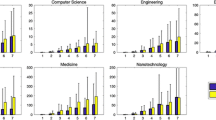Abstract
The extent to which an article attracts citations has long been of interest. However, recent research has emphasized not just the receipt but also the pacing of citation. Citation speed has been shown to be affected by journal prestige and self-citation but also public funding of research. Amidst these viewpoints, this paper explores the speed of article citation of a multi-institutional, multi-disciplinary publicly funded research center relative to that of a comparison group of articles. Results indicate that articles by authors affiliated with the center are significantly more likely to have early-cited papers within the year of publication than the random comparison group, with controls by field also being significant. Implications for the ability of a publicly funded center to attract attention toward articles are discussed.

Similar content being viewed by others
Notes
http://admin-apps.webofknowledge.com/JCR/help/h_immedindex.htm, accessed on March 7, 2013.
References
Aksnes, D. (2003). A macro study of self-citation. Scientometrics, 56(2), 235–246.
Bornmann, L., & Daniel, H.-D. (2008). What do citation counts measure? A review of studies on citing behavior. Journal of Documentation, 64(1), 45–80.
Bornmann, L., & Daniel, H.-D. (2010). Citation speed as a measure to predict the attention an article receives: An investigation of the validity of editorial decisions at Angewandte Chemie International Edition. Journal of Informetrics, 4, 83–88.
Cozzens, S. (1989). What do citations count? The rhetoric-first model. Scientometrics, 15(5–6), 437–447.
Garfield, E. (1973). Citation analysis as a tool in journal evaluation. Science New Series, 178, 471–479.
Glanzel, W., & Thijs, B. (2004). The influence of author self-citations on bibliometric macro indicators. Scientometrics, 59(3), 281–310.
Hargens, L. L. (2000). Using the literature: Reference networks, reference contexts, and the social structure of scholarship. American Sociological Review, 65(6), 846–865.
Lewison, G., & Cunningham, P. (1991). Bibliometric studies for the evaluation of trans-national research. Scientometrics, 21, 223–244.
Leydesdorff, L. (1998). Theories of citation? Scientometrics, 43(1), 5–25.
MacRoberts, M., & MacRoberts, B. (1996). Problems of citation analysis. Scientometrics, 36(3), 435–444.
Merton, R. K. (1973). The Matthew effect in science. In R. K. Merton (Ed.), The Sociology of Science. Theoretical and Empirical Investigations (pp. 439–459). Chicago: Chicago University Press.
Porter, A. L., Cohen, A. S., Roessner, J. D., & Perreault, M. (2007). Measuring researcher interdisciplinarity. Scientometrics, 72(1), 117–147.
Rafols, I., Leydesdorff, L., O’Hare, A., Nightingale, P., & Stirling, A. (2012). How journal rankings can suppress interdisciplinary research: A comparison between innovation studies and business & management. Research Policy, 41(7), 1262–1282.
Rogers, J. (2010). Citation analysis of nanotechnology at the field level: Implications of R&D evaluation. Research Evaluation, 19(4), 281–290.
Rogers, J. (2012). Is the difference in research center productivity real?: The effect of concentration of human resources in centers. Presentation at the Innovative Methods for Innovation Management and Policy Conference, Beijing.
Rogers, J., Youtie, J., & Kay, L. (2012). Program-level assessment of research centers: Contribution of nanoscale science and engineering centers to US nanotechnology national initiative goals. Research Evaluation, 21(5), 368–380.
Rousseau, R. (1999). Temporal differences in self-citation rates of scientific journals. Scientometrics, 44(3), 521–531.
Schubert, A., Glanzel, W., & Thijs, B. (2006). The weight of author self-citations. A fractional approach to self-citation counting. Scientometrics, 67(3), 503–514.
Shadish, W., Tolliver, D., Gray, M., & Gupta, S. (1995). Author judgements about works they cite: Three studies from psychology journals. Social Studies of Science, 25(3), 477–498.
Van Raan, A. F. J. (2004). Sleeping Beauties in science. Scientometrics, 59(3), 467–472.
White, M., & Wang, P. (2000). A qualitative study of citing behavior: Contributions, criteria, and meta level documentation concerns. Library Quarterly, 67, 122–154.
Youtie, J., Kay, L., & Melkers, J. (2013). Bibliographic coupling and network analysis to assess knowledge coalescence in a research center environment. Research Evaluation, 22(3), 145–156.
Author information
Authors and Affiliations
Corresponding author
Rights and permissions
About this article
Cite this article
Youtie, J. The use of citation speed to understand the effects of a multi-institutional science center. Scientometrics 100, 613–621 (2014). https://doi.org/10.1007/s11192-014-1297-4
Received:
Published:
Issue Date:
DOI: https://doi.org/10.1007/s11192-014-1297-4




